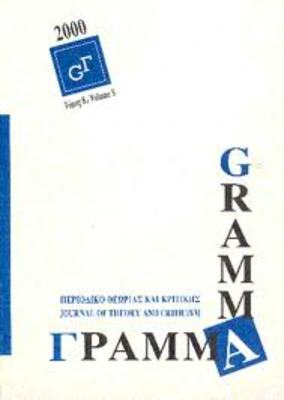Biblical Windows
Part of : Γράμμα : περιοδικό θεωρίας και κριτικής ; Vol.20, 2012, pages 93-104
Issue:
Pages:
93-104
Author:
Abstract:
This paper examines different translations of the Bible from Hebrew, a Semiticlanguage, into Indo-European languages, using the methodology ofroot semantics and focusing on the Hebrew terms translated into Englishas “window”. Analysing the semantics of the roots of the Hebrew terms,we discover that in addition to the concept of “window” as an opening ina wall, they also have varying significations of whiteness, light, prophecy,purity, judgment, cleansing, and blessing. All the Hebrew terms are traversedby the idea of light and purity, and also display different transformationsof the idea of light, meanings which are lost in translation intoIndo-European languages. The theoretical implication is that there are inBiblical Hebrew meanings that never pass to the Indo-European translations,because the Hebrew language is the vehicle of a worldview totallydifferent from that of the Indo-European languages.
Subject:
Subject (LC):
References (1):
- Almalech, M. “The Eight Kinds of Linen in the Old Testament”. Lexia, Journal of Semioticsn.s. 7-8 (2011): 325-364. Print.Berlin, B., P. Kay. Basic Color Terms: Their Universality and Evolution. Berkeley &Los Angeles: University of California Press, 1969. Print.Chandler, D. Semiotics for Beginners. University of Wales, Aberystwith. E-book, 1994-2001. http://www.aber.ac.uk/media/Documents/S4B/semiotic.html. Web. July 25,2005.––. Semiotics: The Basics. First published Routledge, 2002. E-edition Taylor & Francise-Library, 2007. Print.Derrida, J. Monolingualism of the Other, or, The Prosthesis of Origin (1996). Stanford:Stanford University Press, 1996. Print.Lakoff, G. Women, Fire, and Dangerous Things: What Categories Reveal about theMind. Chicago and London: The University of Chicago Press, 1987. Print.Lakoff, G., and M. Johnson. Metaphors we live by. Chicago, IL & London: Universityof Chicago Press, 1980. Print.Lee, P. The Whorf Theory Complex: A critical reconstruction.Amsterdam & New York:John Benjamins, 1996. Print.Leone, M. Saints and Signs: A Semiotic Reading of Conversion in Early ModernCatholicism. Berlin and New York: Walter de Gruyter, 2010. Print.MacLaury, R. (1995) “Vantage Theory”. In Language and the Cognitive Construal ofthe World: Trends in Linguistics. Ed. John R. Taylor, and Robert E. MacLaury.Berlin & New York: Mouton de Gruyter, 1995. 231-276. Print.Nöth, W. Handbook of Semiotics. Bloomington & Indianapolis: Indiana UniversityPress, 1995. Print.Ricoeur, P. “Structure and Hermeneutics”. In: The Conflict of Interpretations: Essaysin Hermeneutics. Ed. D. Ihde. Evanston, IL: Northwestern University Press, 1974.27-61. Print.Rosch, E. [=E. R. Heider]. “Universals in Color Naming and Memory”. Journal of ExperimentalPsychology 93.1 (1972): 10-20. Print.––. “Natural Categories”. Cognitive Psychology 4 (1973): 328-350. Print.––. “The nature of mental codes for color categories”. Experimental Psychology:Human Perseption and Performance 1 (1975): 303-332. Print.––. (1975b) “Universals and cultural specifics in human categorization”. In Cross-culturalPerspectives on Learning. Ed. R. Brislin, S. Bochner and W. Lonner. NewYork:Wiley, 1975. 177-206. Print.––. “Cognitive representations of semantic categories”. Journal of Experimental Psychology104 (1975): 192-233. Print..––. “Human categorization”. In Advances in Cross-cultural Psychology. Vol. 1. Ed.N. Warren. New York: Academic Press, 1977. 1-72. Print.––. “Principle of categorizations”. In Cognition and Categorization. Ed. E. Rosch andB. Lloyd. Hillsdale: Lawrence Earlbaum, 1978. 27-48. Print.Rosch, E., C. Mervis, W. Gray, D. Johnson, P. Boyes-Braem. “Basic Objects in NaturalCategories”. Cognitive Psychology 8 (1976): 382-439. Print.Scholem, G. “On Our Language: A Confession”. Trans. O. Wiskind. History and Memory2.2 (1990): 97-99. Print.Shimron, J. Reading Hebrew: the Language and the Psychology of Reading It. Mahwah,NJ: Lawrence Erlbaum, 2006. Print.Skeat, W. Concise Dictionary of English Etymology. Ware, Hertfordshire: Wordsworth,1993. First published 1884. Print.Trabant, J. Humboldt ou le sens du langage. Liège: Madarga, 1992. Print.Trask, R. Key Concepts in Language and Linguistics. New York & London: Routledge,1999. Print.Underhil, J. Humbold: Worldview and Acknowledgements. Edinburgh: Edinburgh UniversityPress, 2009. Print.Wierzbicka, A. (1990) “The Meaning of Color Terms: Semantics, Cultures and Cognition”.Cognitive Linguistics 1.1 (1990): 99-150. Print.Witkowski, S., and C. Brown (1977) “An Explanation of Color Nomenclature Universals”.American Anthropologist 79.1 (1977): 50-57. Print.Bible texts and translationsBibleWorks. 4BibleWorks98. Norfolk, VA: BibleWorks, 1998. Web.KJV King James Version of the English Bible. 1769 Blayney Edition of the 1611translaation. Authorised Version. ASCII version by the Online Bible Foundationand Woodside Fellowship of Ontario, 1988-1997.Web.LXT Septuaginta. Old Greek Jewish Scriptures. Ed. Alfred Rahlfs. Stuttgart:Württembergische Bibelanstalt / Deutsche Bibelgesellschaft, 1935. Print.NAU The New American Standard Bible. 1977 and 1995 editions. Lockman Foundation, 1986. This translation is an updated edition of the ASV, with the entireBible completed in 1971. Print.NRS The New Revised Standard Version of the Bible. National Council of the Churchesof Christ in the United States of America, 1989. Print.NKJ The New King James Version. Thomas Nelson, Inc, 1982. Print.WTT Biblia Hebraica Stuttgartensia. 4th corrected edition. Ed. K. Elliger and W. Rudoph.Stuttgart: Deutsche Bibelgesellschaft, 1966, 1977, 1983, 1990. Print.Библия 1940. Библия или Свещеното Писание на Стария и Новия заветъ. Вярнои точно преведена отъ оригинала. Ревизирано издание. София, Придворнапечатница. Първо издание 1871. Bulgarian protestant Bible. First printed1871. Print.Библия 1992. Библия сиреч книгите на Свещеното писание на Вехтия и Новиязавет, издава Св. Синод на Българската църква, София, 1992. Първо изда-ние 1925. Bulgarian orthodox Bible. First printed 1925. Print.




